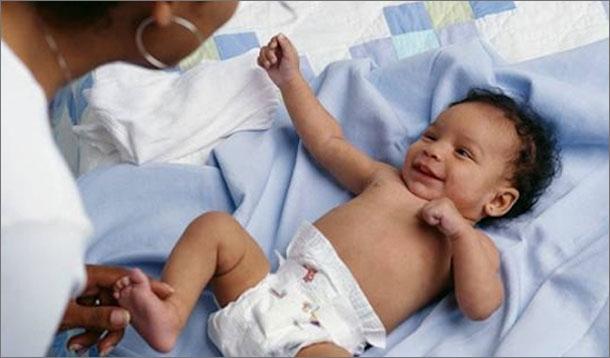
Your baby's expression and body language are the primary way he communicates with you before he starts to talk. Understand what he is "saying" by interpreting the message he sends with his face and body.
Your baby's face is generally easy to read. When he is interested in something, he may raise his eyebrows, look intently at the object for a couple of minutes and cock his head slightly to the side as if listening. Respond by identifying the object he is interested in to help develop his language skills. For example, “Are you looking at the cat?” When your infant is angry, you will definitely know. His jaw may be clenched, his face may be red and his eyes may be narrowed. He may be frustrated by something, like the ball that rolled under the couch. In that case, retrieve the ball for him but otherwise you may just have to wait for the storm to pass. Your infant may be upset because you took something away from him, and he needs to learn that just because he is angry you will not be giving the object back. What you don't want to teach your baby is that temper tantrums get the desired results.
If your baby turns his head away, it could mean that he needs a few moments to process new information or some time on his own. He may be tired of the game or all of the attention he is getting, and just needs some time to play independently.
The first words babies understand are often those that are accompanied by hand movements, such as "bye bye" that cues baby to wave. Babies will "windmill" their arms, flapping them in the air, when they are excited. When accompanied by a smiling face, it is good excitement, e.g. when your baby sees you approach his crib. But at other times, his rotating arms can have a very different meaning. Accompanied by a red, scrunched up face, they can indicate surprise or frustration. At times, arms can communicate a message when they are seemingly doing nothing. When your baby is fearful, he may draw in his arms against his body… an instinctive and self-protection action. When his arms are outstretched with his hands open, this usually indicates a good mood, and that baby is in a receptive mood. He may be happy to come along while you do errands or go shopping, for example, even though the last time you took him shopping, he had a meltdown in the store. Based on his body language, chances are good that this time he will be fascinated by what's going on around him. Experts advise that along with body language, watch your baby's face. That is most easily understood and sends the primary message, with any hand or arm motioning complementing that message. Look at the context of the message as well. A baby who raises his arms up in the air is generally letting you know he wants to be carried but if he is in his playpen, he may just be asking to be lifted out.
When your baby thumps his legs against the high chair, his message is usually an unmistakable “Let me out!” When your baby bangs his legs against his mattress, this is usually his way of saying “Where are you?” and indicates he wants attention and activity. He'll also use his legs to communicate frustration, as when he thrashes them about in a temper tantrum. Vigorous body language generally communicates a strong message, with the thrashing or windmilling of legs serving as the exclamation point to baby's message.
Interestingly, studies have noted that a baby's feet can be indicators of mood too. When a baby's big toe is extended, this may indicate he is in pain. When his toes are slightly curled and pointing down this may be a sign that he is feeling uncomfortable. If his whole foot is stiff and pointing to the floor, it may mean he is in acute pain. Again, look at the whole context – from your baby's face along with his body language – to properly interpret his message. Together they communicate your baby's mood.